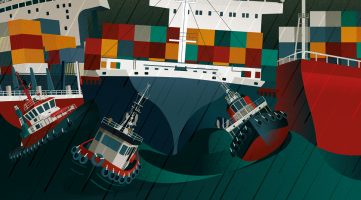Introduction
A global pandemic, lockdowns, working from home, supply-chain disruption, extreme weather, war in Europe, rocketing gas prices, forced migration on a massive scale, high inflation, growing debt burdens, reshoring, friendshoring … This non-exhaustive – yet quite exhausting – list of events would be challenging enough for governments and firms if it was spread over a decade or more. And yet, all of this has happened in the space of just three years, with the prospect of more turbulence to come.
Foreword
A global pandemic, lockdowns, working from home, supply-chain disruption, extreme weather, war in Europe, rocketing gas prices, forced migration on a massive scale, high inflation, growing debt burdens, reshoring, friendshoring … This non-exhaustive – yet quite exhausting – list of events would be challenging enough for governments and firms if it was spread over a decade or more. And yet, all of this has happened in the space of just three years, with the prospect of more turbulence to come.
It is clear that there will be no going back to the “business as usual” of the pre-pandemic period. Our approach to work has been revolutionised, while the invasion of Ukraine and the resulting energy crisis are transforming our thinking on energy and food security, prompting a major reassessment of how economies and businesses obtain critical raw materials and complex parts and components.
The title of this year’s report – “Business Unusual” – encapsulates the tectonic shifts that policymakers and businesses have had to deal with (and will continue to face for some time yet). The report naturally focuses on the ways in which these developments have played out in the EBRD’s regions of operation. Drawing on a plethora of fresh survey data, as well as other newly compiled information, the report presents rich analysis that can inform both public policy and corporate decision-making.
The report begins with an exercise in economic history, taking a broad look at the economics of war and peace and examining the impact that armed conflicts have had on economies over the last two centuries. Such a retrospective is useful and necessary in the current circumstances, as it provides some indication of the sheer scale of the challenges that Ukraine has been subjected to and will face when the war ends. This, in turn, can help to inform policymakers’ short and long-term responses to those challenges.
The focus of the report then shifts to an area where the war has already had a major impact and further policy responses may be needed, namely, the recent mass migration of people escaping the conflict. That wave of Ukrainians fleeing the country is just the latest in a string of refugee crises precipitated by armed conflict, having been preceded by waves of migration from Syria, the former Yugoslavia and many other theatres of war. Newly collected survey data document the human toll of escaping such conflict and refugees’ uncertainty about what the future has in store for them, but they also showcase examples of refugees successfully integrating into the economies of their host countries.
Another key focus of this report is the rethinking of supply chains in the face of major disruption and geopolitical shifts. Until fairly recently, high levels of efficiency and low costs were the only considerations when it came to sourcing raw materials and deciding where to set up production facilities. This paradigm started to be challenged during the trade wars at the end of the last decade and the debate really ignited in the early months of the Covid-19 pandemic, when the supply of critical goods and equipment was disrupted. The war in Ukraine and Russia’s weaponising of energy supplies and raw materials have provided further impetus for the rethinking of supply chains. As this report shows, the process of reorganising supply chains to boost their resilience has already begun. At the same time, however, the report also provides a stark warning: there is a real danger that, if taken too far, such a focus on resilience will result in a world that is split into trading blocs, causing substantial welfare losses for the vast majority of countries.
The various shocks to business activity over the last few years have resulted in ever-increasing levels of corporate debt. This raises questions of sustainability, especially with interest rates rising rapidly in response to the increase in inflation. Although shielding firms from creditors was the right thing to do in the extraordinary circumstances of the pandemic, the perpetual rolling-over of credit to non-viable firms leads to their zombification – and that, in turn, hampers creative destruction, which is a vital element of a healthy and vibrant economy.
Where do all of these observations leave us? One thing is sure: decision-making under extreme uncertainty is here to stay. Governments and firms will need to equip themselves better in the face of this formidable challenge. And while they are implementing short-term stabilisation measures in response to the immediate storm, policymakers and business leaders should keep their eyes firmly fixed on the long-term prizes: green energy and free trade – the foundations of future economic growth.

Beata Javorcik
Chief Economist, EBRD
Highlights
EVENTS
WHERE WE WORK
The EBRD is investing in changing people’s lives and environments across a region that stretches from central Europe to Central Asia, the Western Balkans and the southern and eastern Mediterranean.









